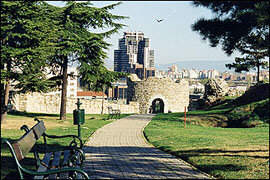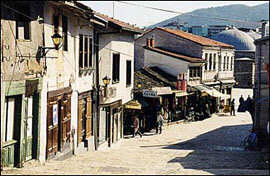 CHRONOLOGY OF HISTORICAL EVENTS CHRONOLOGY OF HISTORICAL EVENTS |

Iron age Macedonians formed during the Iron Age, from Brygian substratum and from Indo-European substratum, settled here at the end of the II millennium; the Macedonians, according the legends got their name from the mythological ancestor Makedon.
Maketa, the oldest name of Macedonia (Makedonis) , after the mythological original ancestor Maketa.
498-454 BC Alexander I called Philhellene; in the year 478 Lower Macedonia on the East, is united to Ennea Hodoi (later Amphipolis) on the river Strymon and on the South to Pydna; Persian ally in the Greek-Persian wars; Macedonia already appears on the international scene.
369 BC Alexander II waged war in Thessalia and left Macedonian garrisons in the Thessalian cities.
360/59 BC Philip II, the greatest man that Europe had ever given united Macedonia and enforced Macedonian dominance upon the neighboring nations; in 357 Athens declared war against him, inside it was divided into anti-Macedonians, so called Hellenists and pro-Macedonians or Philipists. In the year 356 Athens established an anti-Macedonian coalition with the Illyrians, Thracians and the Paionians. Philip unified with the Chalkidian League. 349 Philip demolished Stageira, the birthplace of Aristotle, and in 348 the town Olynthos was demolished. In 345 the Illyrians were conquered, except those who lived along the Adriatic Sea. In 340 Philip besieged Byzantion and Perinthos, he was in war with the Skythians. The sixteen year old Alexander replaced him on the throne and undertook a campaign to the Maidoi and established the city Alexandropolis; In 339 Philip defeated the Triballians on the northern border of Macedonia.

338 BC The Hellenes were defeated during the battle at Chaironea. Philip became a hegemon to the Hellenes who signed the mutual peace agreement in Corinth.
336 BC Alexander III. In the midst of preparations for the campaign agains Persia, in order to settle the question of hegemony in the East Mediterranean, Philip was killed in Aigai.
336 BC Alexander III (or the Great) renewed the Macedonian dominance over the Thracians, Tribalians and Illiyrians. 334 - The beginning of of the new historical epoch - Hellenistic (Macedonian) period which lasted until the fall of the last Macedonian monarchy.
323 BC After the death of Alexander, in the struggles for dominance of his associates, the Diadochi, both his sons were killed before reaching adult age. This meant the disappearance of the dynasty of Argeadai. As a result of this and of the Celtic invasion Macedonia was in chaos.
179-168 BC Perseus Macedonia falls under Roman protectorate.
148 BC Macedonia was given the status of a province (Roman army and administration).
cca 51 AD For the first time on European soil, in the Macedonian towns Philippi. Thessalonici and Beroea the Apostle Paul preached Christianity .
VII The process of ethno-genesis of the modern Macedonian people by mixing of the natives, the ancient Macedonians and the Slavs started.
| IX The Slavic tribes in Macedonia accepted Christianity as their own religion. The brothers, Cyril and Methodius, who created the Slavic alphabet, were promoters of Christianity and founders of Slavic literacy among the Slavic people. Through their activity the language of the Slavs from Macedonia, after the Greek, Latin and Jewish, became the fourth official language in which Christianity would be spread in Europe.
X The Macedonian Meieval State was established during the period of czar Samouil (976-1018).
XI The Ohrid Archbishopric with main seat in Ohrid was founded during the rule of czar Samouil; Petar Delian organized a rebellion (1040-104); Gjorgi Voytech organized a rebellion (1072).
XII The Macedonian feudal lord Dobromir Hrst became independent.
XIII The rule of the Macedonian feudal lord Strez.
XIV The rule of the dynasty Volkasin in Macedonia. Near the end of the XIV century Macedonia fell under Turkish rule and remained as such for five centuries.
XVI In Mariovo and Prilep the people had begun an uprising against the Turkish rule.
XVII The Karpos uprising had begun.
XIX In the second half of the XIX century the national and revolutionary struggles for freedom in Macedonia began; the uprisings in Razlovci and Kresna.
August 2, 1903 The Ilinden uprising had begun. The rebels in the town of Krusevo organized their own power, well known as the Republic of Krusevo, which lasted 10 days.
1908 The Young Turk revolution. The Macedonian revolutionary organization, led by Jane Sandanski, and the newly formed National Federal Party actively took party in the Young Turk movement in order to achieve autonomy for Macedonia.
1912 First Balkan War in which the allied Balkan countries, Serbia, Bulgaria, Montenegro and Greece achieved victory over Turkey.
1913 The Second Balkan War was led by the country allies from the First Balkan War (Serbia, Greece, Bulgaria) with the aim of ruling Macedonia.
August 10, 1913
Peace treaty in Bucharest - The Macedonian territory was split in between Bulgaria, Serbia and Greece.
First World War. In 1915 Bulgaria occupied Macedonia.
1919 The Treaty of Versailles. The partition of Macedonia was sanctioned, by the Balkan countries: The Kingdom of Serbia, Croatia and Slovenia, Bulgaria, Greece and Albania.
1941 The Bulgarian and Italian military forces occupy the Vardar part of Macedonia.
October 11, 1941 Beginning of an armed battle in Macedonia with a national and revolutionary character, for the realization of an independent Macedonian state.
August 2, 1944 The First session of the Antifascist Council for the National Liberation of Macedonia, ASNOM, was held at the monastery of St. Prohor Pcinski. The ASNOM presidium was formed then. A decision was reached to constitute a modern Macedonian country that will become part of the new Federal Yugoslavia.
April 1945 The First Macedonian government was founded with Lazar Kolisevski as its first president.
July 17, 1967 The Ohrid Archbishopric was renewed as the Macedonian Orthodox Church on September 8, 1991. There was also a referendum when the people voted for the independence of the Republic of Macedonia.
November 17, 1991 The Constitution of the Republic of Macedonia was passed according to which: "Macedonia is constituted as a national country of the Macedonian people which guarantees complete civil equality and permanent mutual living of the Macedonian people with the Albanians, Turks, Vlachs, Romas and other nationalities living in the Republic of Macedonia.
April 8, 1993 The Republic of Macedonia was admitted in the United Nations. |

